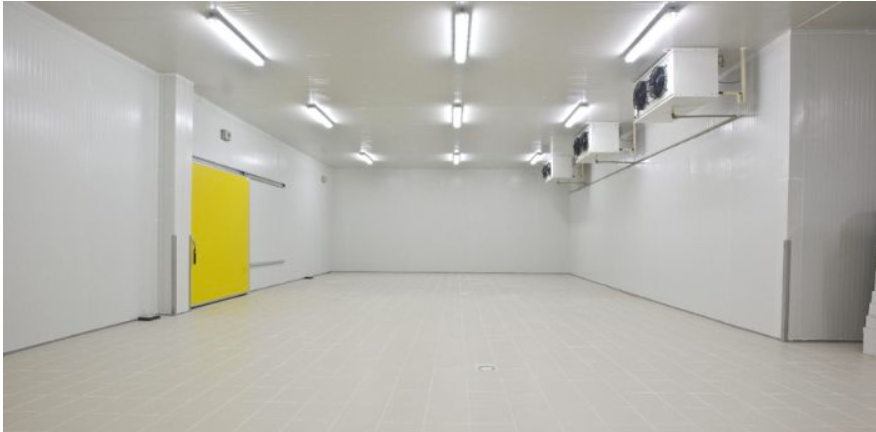What ls the difference between a walk-In cold room and a walk-in Freezer

How do large quantities of produce stay fresh? Why does ice cream stay frozen even when left unattended? The answer is simple – because there are walk-in coolers and freezers, but there is a clear difference between the two. SDpanel, a well-known Chinese brand, is here to introduce the difference between walk-in cold room and walk-in freezer.
Walk-in Refrigeration System Classification
A walk-in refrigeration system is a large, insulated room that is usually used to store products that are prone to expiring or spoiling. It includes a walk-in cold room or walk-in freezer.
Walk-in cold room
Walk-in cold room otherwise called walk-in coolers are large rooms that are insulated and work like a refrigerator, only bigger. These rooms are commonly used by businesses that require storage for food and products that are perishable. Its primary function is to “chill” the products stored inside. Walk-in cold room is designed for short-to-medium term storage of perishable items that need to be kept cool but not frozen.
Walk-in Freezer
Walk-in freezers are large, equally insulated rooms that work like full-size freezers. It seems the same as a walk-in cold room, but the main difference is its working temperature. The temperature range of walk-in freezers is usually from -10’F to -40’F (-23’℃ to -40’C). lts primary function is to “freeze” the products stored inside to preserve food and keep it for a long time. Walk-in freezers is designed for long-term storage of items that need to be kept frozen solid.
The difference between a Walk-in Freezer and a Walk-in Cold Room
Although the principles of both are the same, the main difference between a Walk-In Cold Room and a Walk-In Freezer boils down to temperature range and application
Temperature Range
- Walk-In Cold Room (Refrigerator): Operates above freezing point, typically between 0°C to 10°C (32°F to 50°F). Its primary function is cooling to slow spoilage.
- Walk-In Freezer: Operates below freezing point, typically at -18°C (0°F) or lower (often down to -23°C / -10°F). Its primary function is freezing to halt bacterial growth and preserve food long-term.
Application
- Walk-in cold room is perfect for storing perishable items that need to remain cool but should not freeze.
Examples: Fresh fruits & vegetables, dairy products (milk, cheese, yogurt), eggs, fresh meat & poultry (for short-term use), beverages, prepared foods, flowers, some pharmaceuticals.
- Walk-in Freezer is used to store products that need to be frozen for an extended period to preserve their freshness, such as meat, seafood, and ice cream.
Examples: Frozen meats, poultry, seafood, ice cream, frozen vegetables & fruits, pre-made frozen meals, ice, dough, extended storage inventory.
Insulation & Construction
- Walk-in cold roomCan often use slightly thinnerinsulation (e.g., 75mm or 100mm / 3″ or 4″ panels) since the temperature differential with the ambient environment is less extreme.
- Walk-in freezer requires thicker insulation (often panels 100mm, 125mm, or even 150mm / 4″, 5″, 6″ thick) to minimize heat transfer and maintain the much lower temperatures efficiently. Doors also have much heavier insulation.
Refrigeration System
- Walk-in cold room uses a standard refrigeration system designed for above-freezing temperatures. It’s less powerful and energy-intensive than a freezer system for the same size space.
- Walk-in freezer requires a more powerful refrigeration system capable of achieving and maintaining sub-zero temperatures. The compressor and evaporator coils are designed to handle lower suction pressures and potential frost buildup.
Frost Buildup & Defrost
- Walk-in cold room: Frost buildup is minimal or non-existent at typical operating temperatures. Usually does not require an active defrost cycle; any minor frost melts naturally during off-cycles.
- Walk-in freezer: Frost buildup on evaporator coils is a significant issue due to moisture in the air freezing. Requires regular automatic defrost cycles (electric, hot gas, or water).
Cost
- Walk-in cold rooms are generally cheaper compared to walk-in freezers because of its function which requires a higher temperature setting than freezers. Of course, the operating cost is also lower
- Walk-in freezer: generally more expensive to purchase and install due to thicker panels, heavier doors, and a larger/more powerful refrigeration system. Also higher operating costs due to greater energy consumption.
In Summary
Based on the above analysis and comparison, you can make a wise choice. Choose a Cold Room if you need to keep items cool and fresh, but not frozen (like a giant refrigerator).
Choose a Freezer if you need to keep items frozen solid for long-term storage. Many facilities (restaurants, warehouses) have both!
